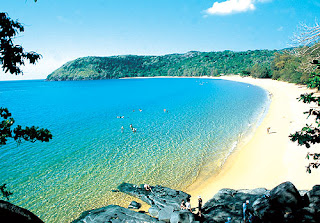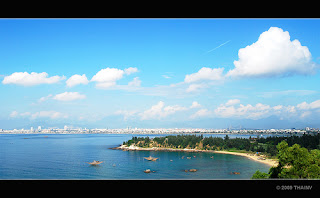Whoever visiting Phan Thiet City, Binh Thuan Province could not help a journey to Mui Ne – a gracefully seductive sea cape!
Introduction
22 kilometers North Eastern Phan Thiet, Binh Thuan Province, Mui Ne is a group of beaches, such as Ong Dia beach, Front beach and Back Beach.
The name “Mui Ne” derived from the fact that fishersmen get in here to hide the storm on their fishing days. “Mui” means cape, and “Ne” means hiding. Tourists can easily be attracted by the deep blue of the sea, the goldern of the sun and sand, all converging in warmth and purity.
Quick look
What makes Mui Ne a different fascinating seaside painting? The answer consists of quite a few elements, such as beautiful beaches gently sloping to the sea, gentle breezes, pure sea, blue sky, and cristine reddish sand dunes. More importantly, though grown up from a distant seaside far from the highway (with scattered poor fishing villages) to a community of hundreds of high-quality resorts, Mui Ne is still called the “Desert of golden sand”. Still, visiting Mui Ne, you can see by your own eyes the fishing village “Mui Ne” – a typical Vietnam’s fishing seaside land in its daily life.
What is more, the all-the-year-round sunny weather facilitates any swimmer.
Zoom
Mui Ne is a precious gift of Nature, with the most beautiful sand – banks in Vietnam. The sand gathers together making the endless accumulated hills. Sand hills have been sources of inspiration for numerous photographers for years. Standing on top of the hills, you can easily feel the cool winds from the sea. Seldom can tiredness so quickly disappear!
Among others, Ong Dia beach is the finest one in Mui Ne, the beauty of which is revealed in the ever cristine state, long-lasting sand banks and coconut-palm paths. As one of the best seasides in Vietnam in terms of both natural beauty and sea entertainment kinds. Just take a holiday here, you will have chances to taste a series of delicious seafood, and enjoy various interesting activities, for example, swimming, boat sailing, sun bathing, surfing, golf, scuba-diving and snorkeling, hunting, sight-seeing, or hide into a charming and relaxed night life with live music or local sea festivals. If you would like to try something more uniquely typical Mui Ne beach, you could spend time visiting the oldest towers in Vietnam, Ponshanu or
Mui Ne sand
Phu Hai, 1,200 years old, which are luckily to be located here. Those are the work of Cham people. As years have gone, leaving time raveges down on here, their solid existence is the firm witness of Cham culture improvement. For further sight-seeing, tourists may take a walk to Ong Hoang Storey, Rom Island, or Mui Ne Sand dune (or in other words, Flying Sand dune).
Flying Sand dune is one of the longest Sand banks stretching a series of kilometers and areas. Its name derives from the main golden color with the existence of hundreds of years. Why is it “flying”? It is the answer that makes it differ: the shape changes hourly, daily, monthly, etc. due to the wind, which absorb a number of tourists elsewhere. The dunes are frequently tectonics of different shapes: animal, lying lady, etc. Also, its varied color, such as red, white, pink, whitish grey, and reddish grey, etc. are inspiration of so many artists, among whom is Y Lan, who has created such a new special kind of art – sand painting. This is one of the brand new unique modern kinds of arts in current Vietnam, truly worth your discovery!
Thanks to Sand Dunes, the premium special element of Mui Ne seaside, the local government has built Binh Thuan’s special tourism product, that is, modern golf on sand with planted green confetti, poplar, etc. The golf zone is a part of a qualitative resort area, hostel system, great destination of relaxation for all tourists.
I have asked a number of foreign tourists to Vietnam the same question, “What do you like most in Vietnam?” The most frequent answer is Beaches, and one of the top seaside around Southern Vietnam is Mui Ne! You should also come and feel the beautiful sea, long sand dunes and fresh breeze yourself!





























